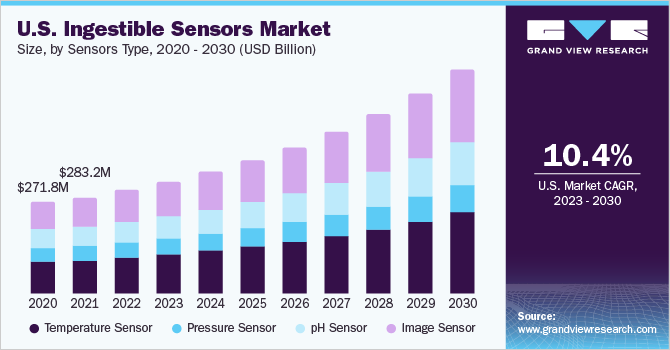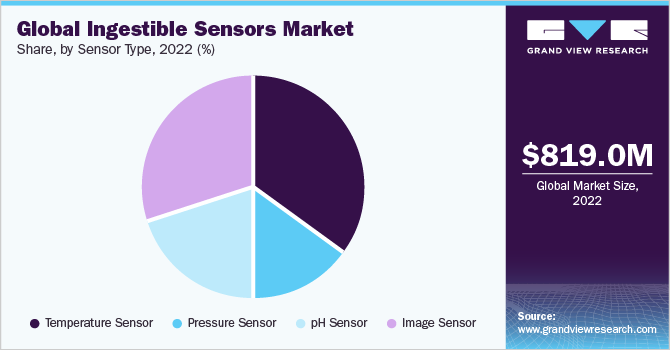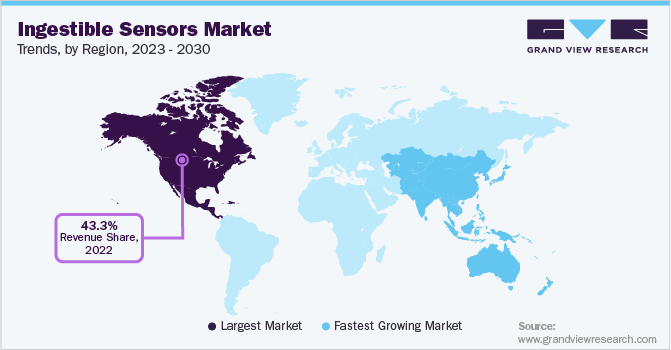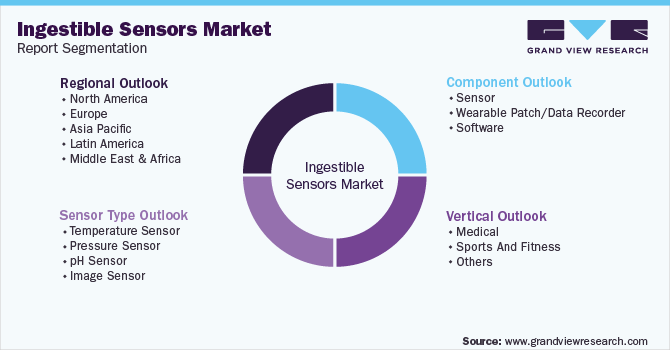- Home
- »
- Medical Devices
- »
-
Ingestible Sensors Market Size, Share & Growth Report, 2030GVR Report cover
![Ingestible Sensors Market Size, Share & Trends Report]()
Ingestible Sensors Market Size, Share & Trends Analysis Report By Component (Sensors, Software), By Vertical (Sports, Medical), By Sensor Type (Temperature, Pressure, Image Sensors), By Region, And Segment Forecasts, 2023 - 2030
- Report ID: 978-1-68038-923-4
- Number of Report Pages: 100
- Format: PDF, Horizon Databook
- Historical Range: 2017 - 2021
- Forecast Period: 2023 - 2030
- Industry: Healthcare
Report Overview
The global ingestible sensors market size was valued at USD 819.0 million in 2022 and is anticipated to witness a CAGR of 10.90% from 2023 to 2030. An ingestible sensor is a vital healthcare device that aids in diagnosis and monitoring. Technological advancements and the growing prevalence of chronic disorders are some of the major factors driving the market. Factors including the need for medical adherence and increasing healthcare awareness among people are likely to boost the market growth.

Extensive product usage in various medical applications including modified drug delivery is contributing toward the market growth. These devices are non-invasive and have a user-friendly design that assists in real-time diagnosis and health monitoring. Increasing cases of complications caused due to the various chronic diseases, as a result of negligence toward prescription by the patients, is boosting the product demand.
The adoption of Internet of Things in the medical/healthcare industry is on the rise. This has resulted in increased research on smart pills and Wirelessly Observed Therapy (WOT). For instance, according to a study published in October 2019, in PLOC Medicine, better results were shown by a novel edible sensor, connected to a paired mobile device to monitor the TB medication intake, than the directly observed therapy. Similarly, in May 2018, an article was published in the journal Science, about an edible micro-bio-electronic device (IMBED), developed by the researchers, that can be used for monitoring gut health.
Stringent government regulations and need for the expensive technology are some of the factors that could hinder the growth of this market. The product designing and development is an expensive method and requires advanced integrated technologies along with high-end R&D infrastructure. Moreover, strict guidelines are set by different regulatory authorities to uphold the safety and effectiveness of a proposed medical product.
COVID-19 Ingestible Sensors Market Impact: 0.9% Decrease from 2019 to 2021
Pandemic Impact
Post COVID Outlook
The COVID-19 negatively impacted the market owing to the supply chain disruptions and the temporary closure of manufacturing facilities. Furthermore, various ongoing researches on edible smart pills was delayed or put on halt due to the pandemic.
The market is expected to have positive growth post-pandemic owing to the resume of business and research activities and an increase in the number of capsule endoscopy procedures.
A decrease in the number of endoscopy procedures resulted in low sales of the ENDOCAPSULE 10 System manufactured by Olympus Corporation.
Market growth will remain stagnant for a few years owing to the decline in the number of product launches and the number of new entrants in recent times.
According to the International Diabetes Federation (IDF), nearly 537 million adults were living with diabetes in the world in 2021. The number is projected to reach 643 million by 2030. Nearly 11.0% of Americans have a chronic digestive disease. This rising prevalence of chronic diseases is increasing need for the medical products to control and manage various chronic diseases. Smart pills can prove to be useful in the management of such diseases as they are non-invasive, wireless, and can reduce the burden on care providers.
Component Insights
Based on components, the sensor segment dominated the market in 2022 with a share of 46.0% and it is projected to register the highest CAGR of 11.23% during the forecast period. This can be attributed to huge R&D investments and new product launches. For instance, in December 2019, etectRx, a Florida-based company, received the U.S. FDA approval for ID-Cap System. The ID-Cap system is a prescription ingestible system that delivers the adherence event logs to an externally connected medical device. It contains a sensor that sends a signal when it comes in contact with gastric fluids.
The sensor technology also helps reduce hospital visits and re-hospitalization, along with round-the-clock remote monitoring, thereby allowing patients to recover within the comforts of their own homes. The software segment is expected to witness lucrative growth during the forecast period. The growth of the segment is mainly due to the continuous efforts by the manufacturers to introduce advanced software to offer more effective ways of disease control and management.
Increasing adoption of the wearable patch among the patient population for disease monitoring is likely to favor the wearable patch/ data recorder segment growth. As per the Canadian Diabetes Association, the prevalence of the disease is growing in Canada and it is said to affect around 5.0 million individuals by 2025. Thus, increasing incidences of the chronic diseases such as diabetes, cancer, arthritis, Alzheimer’s disease, chronic kidney disease, and chronic pain is expected to boost the segment growth.
Vertical Insights
Based on the vertical, the medical segment with a share of 57.3% accounted for the major portion of the market in 2022 and it is expected to have the highest growth rate of 11.4% during the forecast period. These products are widely used in the medical sector where they help diagnose diseases and monitor patient health. In contrast to invasive techniques, which require meticulous procedures and surgical interventions, ingestible sensors allow simplified monitoring of various parameters such as temperature, pressure, and ph.
Another major field of application is sports and fitness. Constant observation of blood pressure and melatonin levels along with other essential body statistics is required to assess the health of players and athletes. They also help athletes monitor food interactions and record relevant data precisely without having to use invasive techniques. All these factors are boosting the product demand in this field.
Edible sensors are used in other areas, where study of the internal anatomy is required. Individuals working in extreme conditions such as firefighters and defense personnel are also required to have a constant check on body temperature and other essential parameters, which is also augmenting the segment growth.
Sensor Type Insights
The temperature sensor held the maximum revenue share of 35.1% in 2022. It is a widely used technique in different verticals such as healthcare and aerospace to measure body temperature in patients and astronauts respectively to detect any drastic temperature changes that might prove fatal if undetected.
The investments in the product’s R&D is higher in developed countries than in emerging regions because of its high-cost technology, availability of well-equipped labs, and early adoption of the advanced medical products in developed regions.

The image sensor segment is projected to grow at a fastest CAGR of 11.8% during the forecast period due to its growing adoption in the healthcare sector. They are widely used in endoscopy procedures. Healthcare professionals can view clear images of various tissues and organs inside a patient’s body by using these sensors, which allows for accurate diagnosis of critical diseases.
Pressure sensor segment is anticipated to have significant growth during the forecast period owing to its advantages in the management of respiratory and cardiac diseases. It allows precursors of cardiac problems to be identified and communicated to the patient earlier allowing fatal problems to be avoided.
Regional Insights
North America accounted for the maximum share of 43.3% in the global ingestible sensors market in 2022 owing to the technological advancements and strategic presence of key manufacturers. Innovations in the field of science and technology that resulted in the development of tiny camera pills, which are widely used in these products, are likely to boost region’s growth. Furthermore, increasing research to use of smart pills for the management of chronic and gastrointestinal diseases is favoring the market expansion.
Europe accounted for a second prominent position followed by North America. Designing of innovative medical devices has been at the forefront for many local European companies. This coupled with the rapid adoption of the latest technology is contributing to the growth of the market in Europe. Other factors such as rising cases of chronic diseases and favorable health reimbursement are also augmenting the demand in Europe.

Asia Pacific is anticipated to witness the highest CAGR of 12.4% during the forecast period owing to an increase in healthcare expenditure and a rise in chronic diseases. Heavy investments by the top companies in R&D are also likely to contribute to regional growth. Countries such as Japan, India, and China are expected to lead the region with increasing adoption of these medical devices for diagnostics and therapeutic purposes. Increased cases of lifestyle-related diseases caused by physical inactivity and unhealthy eating habits are also likely to boost product demand in the region.
Key Companies & Market Share Insights
The major players are focusing on robust R&D, new product launches, and partnerships for strengthening their market positions. For instance, in November 2019, Seed Health announced research collaboration with Atmo Biosciences for analyzing the effect of probiotics on the gut micro biome using the company’s edible gas-sensing capsule. The entry of new players into the market is difficult owing to expensive technology and high manufacturing cost. This makes the market moderately competitive. Some of the prominent companies in the global ingestible sensors market include:
-
Olympus Corporation
-
Otsuka Holdings Co., Ltd.
-
Medtronic
-
etectRx
-
CapsoVision, Inc.
-
H.Q., Inc.
-
IntroMedic
-
JINSHAN Science & Technology
-
Check-Cap
Ingestible Sensors Market Report Scope
Report Attribute
Details
Market size value in 2023
USD 890.4 million
Revenue forecast in 2030
USD 1.8 billion
Growth rate
CAGR of 10.90% from 2023 to 2030
Base year for estimation
2022
Historical data
2017 - 2021
Forecast period
2023 - 2030
Quantitative units
Revenue in USD million, CAGR from 2023 to 2030
Report coverage
Revenue forecast, company ranking, competitive landscape, growth factors, trends
Segments covered
Component, sensor type, vertical, region
Regional scope
North America; Europe; Asia Pacific; Latin America; Middle East & Africa
Country scope
U.S.; Canada; U.K.; Germany; France; Italy; Spain; Japan; China; India; Australia; South Korea; Mexico; Brazil; South Africa; Saudi Arabia, UAE
Key companies profiled
Otsuka Holdings Co., Ltd.; Medtronic; etectRx; CapsoVision, Inc.; H.Q., Inc.; IntroMedic; JINSHAN Science & Technology; Check-Cap
Customization scope
Free report customization (equivalent up to 8 analyst’s working days) with purchase. Addition or alteration to country, regional & segment scope.
Pricing and purchase options
Avail customized purchase options to meet your exact research needs. Explore purchase options
Global Ingestible Sensors Market Report Segmentation
This report forecasts revenue growth at the global, regional, and country levels and provides an analysis on the latest industry trends and opportunities in each of the sub-segments from 2017 to 2030. For this study, Grand View Research has segmented the global Ingestible Sensors Market report based on the component, sensor type, vertical, and region:

-
Component Outlook (Revenue, USD Million, 2017 - 2030)
-
Sensor
-
Wearable Patch/Data Recorder
-
Software
-
-
Sensor Type Outlook (Revenue, USD Million, 2017 - 2030)
-
Temperature Sensor
-
Pressure Sensor
-
pH Sensor
-
Image Sensor
-
-
Vertical Outlook (Revenue, USD Million, 2017 - 2030)
-
Medical
-
Sports And Fitness
-
Others
-
-
Regional Outlook (Revenue, USD Million, 2017 - 2030)
-
North America
-
U.S.
-
Canada
-
-
Europe
-
U.K.
-
Germany
-
France
-
Italy
-
Spain
-
-
Asia Pacific
-
Japan
-
China
-
India
-
Australia
-
South Korea
-
-
Latin America
-
Mexico
-
Brazil
-
-
Middle East & Africa (MEA)
-
South Africa
-
Saudi Arabia
-
UAE
-
-
Frequently Asked Questions About This Report
b. The global ingestible sensors market size was estimated at USD 819.0 million in 2022 and is expected to reach USD 890.4 million in 2023.
b. The global ingestible sensors market is expected to grow at a compound annual growth rate of 10.90% from 2023 to 2030 to reach USD 1.8 billion by 2030.
b. North America dominated the ingestible sensors market in 2022. This is attributable to the technological advancements and availability of sophisticated infrastructure.
b. Some key players operating in the ingestible sensors market include Otsuka Holdings Co., Ltd.; Medtronic; etectRx; CapsoVision, Inc.; H.Q., Inc.; IntroMedic; JINSHAN Science & Technology; Check-Cap.
b. Key factors that are driving the ingestible sensors market growth include technological advancement and the growing prevalence of chronic disorders are some of the major factors driving the market.
Share this report with your colleague or friend.
![gvr icn]()
NEED A CUSTOM REPORT?
We can customize every report - free of charge - including purchasing stand-alone sections or country-level reports, as well as offer affordable discounts for start-ups & universities. Contact us now
![Certified Icon]()
We are GDPR and CCPA compliant! Your transaction & personal information is safe and secure. For more details, please read our privacy policy.
We are committed towards customer satisfaction, and quality service.
"The quality of research they have done for us has been excellent."





